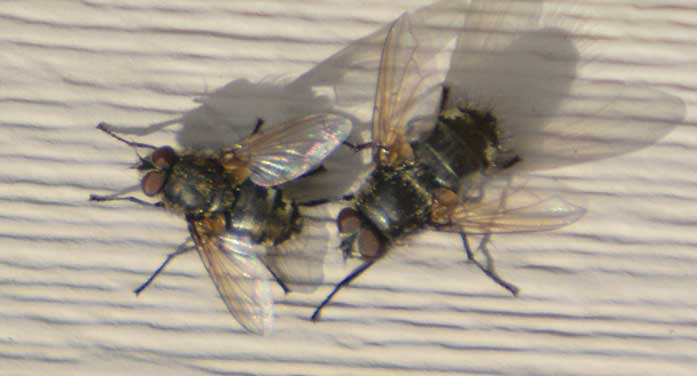
Cluster flies share our home until the temperature outside warms up. Then they attempt to leave and find their way home. Unfortunately, they forget how they got into our homes and end up clustering on the windows, trying to get outside
 It isn’t hard to see that the land is awakening as spring slowly unfolds before our eyes. One of the revelations I always marvel at in the spring is the rapid emergence of insects when it’s still so cold outside.
It isn’t hard to see that the land is awakening as spring slowly unfolds before our eyes. One of the revelations I always marvel at in the spring is the rapid emergence of insects when it’s still so cold outside.
Even though the outside temperature was only a few degrees above freezing at my house last week, I saw honey bees, a hornet, leaf-footed bugs, several fruit flies, some cluster flies and a few ladybugs.
Where the heck did they come from?
For the most part, they emerged when the soil and leaf litter started to warm and conditions were suitable for them to fly and try to find food. This is a risky proposition because they may be doomed if it turns cold again. But somehow, they survive, as they have for eons.
Cluster flies, which follow a slightly different cycle than many of our native species, are opportunistically closely linked to us and our homes. While many overwinter in barns and other areas where they can glean some heat and protection, many more choose our homes for refuge in the fall. So let’s explore their lives a little bit.
Cluster flies are those small, black, slow-moving flies – with small stripes on their heads and golden hairs and a checkered pattern on their abdomens – that we see on our windows and siding at this time of year. They favour south- or west-facing surfaces in particular because these locations are the first to absorb the weak spring sun’s heat.
Most people confuse them with house flies that thrive on rotting meat, but they’re a completely different type of fly.
Sometimes called attic flies, they’re frequently found in our attics (hence the name), but they also may winter in walls or other dead spaces in our homes. In the fall, they enter our houses through tiny cracks and crevices or unscreened vents, then slowly move to their wintering sites inside the home, where they will wait out the cold weather.
They will share our home and stay until the temperature outside rises to about 10C or 12C. Then they emerge and try to find their way back outside. Unfortunately, they have poor memories, so the tiny crack that allowed them to enter our homes is forgotten and they cluster on the windows, trying to get outside.
They pose no risk to humans as their only food is worms and various plant materials, which they parasitize. The female lays her eggs near the little burrows that earthworms create. The eggs develop in the soil for three or four days, and then when the larvae hatch out, they burrow into the nearest worm and feed on it.
After two to three weeks, the maggots emerge from the worm and morph into pupae for another two weeks. After that they become adults and the cycle repeats, often three or four times a year.
Adult cluster flies feed on flower nectar, plant juices, fruit and other types of organic matter.
The use of pesticides to control them is an overreaction and unnecessary. They don’t carry disease, aren’t associated with decaying carcasses or rotten meat, and they don’t damage homes or food. They’re essentially harmless.
So what can you do?
The best remedy is to try to stop them from entering your home in the first place. Caulk any cracks or crevices in the siding and window or door frames in late summer. Repair damaged screens and put mesh over any vents (including soffits) that lead into the house. This will greatly help keep them out of your home.
In the spring, if I find some on my window sills, I simply open the window or screen door and shoo them out. Works perfectly and doesn’t interfere with their life cycle!
By the way, we’re not alone in having them invade our homes. There are over 70 species of cluster flies and they can be found on all continents except Antarctica.
And in case you’re asked, cluster flies emit an odour like buckwheat honey when disturbed. No idea why.
Geoff Carpentier is a published author, expedition guide and environmental consultant. Visit Geoff on LinkedIn, Instagram and Facebook. For interview requests, click here.
The opinions expressed by our columnists and contributors are theirs alone and do not inherently or expressly reflect the views of our publication.
© Troy Media
Troy Media is an editorial content provider to media outlets and its own hosted community news outlets across Canada.


